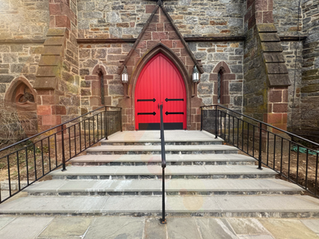NEW Article Published in STRUCTURE Magazine by Ciro Cuono
- Ciro Cuono
- Feb 7
- 6 min read

Featured in the February 2025 edition of STRUCTURE magazine, is "Training, Mentorship, and the Art of Giving Back," an article by Cuono Engineering Principal, Ciro Cuono, PE on training and mentorship within the engineering industry.
The article explores and surveys the state of the industry in terms of its mentorship, training, and ways of giving back and provides creative suggestions on how to improve and formalize the “give back" process.
Training, Mentorship, and the Art of Giving Back
Mentorship can be a mutually beneficial relationship that helps raise the bar of the structural engineering profession.
Milo Ketchum, a renowned 20th century structural engineer, wrote in 1983 in an editorial called “Training Recent Graduates” that “We all seem to agree that the recent graduates we hire for structural offices, are not well trained for our work, and that we do not get our money’s worth for a considerable length of time.” (Structural Engineer Practice-Volume 2, Number 2, 1983). Ketchum then went on to illustrate examples of where he thought recent graduates lacked training and suggested a training program for structural consulting offices that would run for two or three weeks. He suggested that this program would start with a test to identify strengths and weaknesses and include training in drafting and a series of design problems of increasing complexity, including training in computer modeling. Ketchum then went on to conclude that this investment of approximately 4% of a year’s time would result in at least a 4% increase in efficiency and therefore would not be a loss to the employer.
This proposition, now over 40 years old, is quite interesting and raises lots of questions for the education and training of structural engineers today. First, only so much can be accomplished in a four-year engineering program (including perhaps a master’s program as well), hence the common complaint that recent graduates lack some skills to be immediately productive. The world is much more complicated than it was in 1983 and certainly significantly more so than it was in the 1930s when Ketchum was educated. On the other hand, our access to instant information and incredible computing power is tremendous compared to Ketchum’s days. However, there is a limit to what can be taught in a four-year program, particularly when one considers there are few or no “Structural Engineering” degrees at the undergraduate level. What we have are Civil Engineering” degrees where the core courses of structural analysis and design can get easily drowned out in the broader context of the Civil Engineering program.
Read more at STRUCTURE Magazine or continue reading below.
So, for those who empathize with Ketchum’s sentiment, we have to ask ourselves, “What can we expect?” We would not want a medical student, just finishing his or her studies to perform heart surgery without even doing a residency. So, as Ketchum suggested, whether formalized (as he outlined) or not, we, as an industry, have our own form of “residency” in the form of on-the-job training and mentorship. Now, some firms have a more organized way of doing this (e.g. Ketchum type onboarding) while others simply do it in an ad hoc way. In either case, a mid-level or senior structural engineer today practices his or her profession based on their education in first principles (hopefully) and years of on-the-job training and mentorship. Like a medieval carpenter or stone mason, most entry level engineers today work almost in an apprenticeship (albeit generally well paid) under the tutelage of their senior supervisors and mentors. Ketchum’s suggested onboarding program is quite attractive when one considers the time and cost of entry level engineers, particularly in their first year. We are charged with designing the infrastructure of the world, so this responsibility should include organized internal training and apprenticeship so we can continue to perpetuate our craft.
A formalized training program for young structural engineers, however, is not the end goal but just the beginning. Engineering as a profession is hard. We are expected to basically deliver on time, error-free designs day-in and day-out in a world of tight fees, tight schedules, increasingly complex codes, and ever-changing technology. All with having taken say, maybe one or two formalized classes in steel or concrete design. The reality is that the profession of engineering means a lifelong of learning. Many states require continuing education to maintain licensure. This should be the bare minimum as there is always something new to learn in such a complicated profession. Continuing education should be part of any training program (formalized or otherwise). But along with training and continuing education, mentorship is just as critical.
But what exactly is “mentorship”? According to the Merriam Webster Dictionary, the word mentor has its roots in a character of the same name in Homer’s Odyssey. Mentor was entrusted with the education of Odysseus’ son. Fast forward to today and mentorship is a hot word in the business world with many large companies and institutions having formalized programs where more experienced employees provide some form of guidance or mentorship to less experienced employees. A March 2023 article in Forbes entitled “The Power of Mentorship: How Mentors Can Help Employees Grow and Succeed” (March 27, 2023, by Kara Dennison, Forbes) provides seven examples of mentorship:
Traditional Mentorship: a one-on-one relationship where more experienced employees partner with those who need support.
Reverse Mentorship: When the less experienced employee becomes a mentor to someone more experienced.
Group Mentorship: Like the name sounds, it involves a group of employees mentored by one or more experienced employees, perhaps leading to cost efficiencies.
Virtual Mentorship: This is essentially a version of the traditional mentorship relationship except it is done online, perhaps opening up possibilities of pairing people who would otherwise be geographically limited.
Peer-to-Peer Mentorship: Employees at the same or similar level help each other and build a sense of community.
Sponsorship: A sponsor is an influential person within the organization who supports the career development of a less experienced employee.
Onboarding Mentorship: provides new employees with a mentor who can help them navigate the organization and learn the ropes during onboarding.
Most engineers will find some or most of these examples familiar in some fashion, whether formalized or not. Engineering is not just codes and equations but art and judgment as well—not to mention the great amount of personal interaction in the form of communication: texts, emails, calls, memorandums and reports, office meetings, or meetings on an onsite trailer. Learning the craft of our structural engineering profession takes years of training and on the job mentorship. Formalizing a training program underlain by a formalized mentorship program would surely go a long way to responding to Ketchum’s concern on recent graduates and help run more efficient organizations by passing along valuable knowledge and craft.
But the journey does not end there. A young engineer lucky enough to work for an organization that has a formalized training program and takes the time to create a mentorship program must recognize that as they move along their careers, they must give back and reinvest. They must reinvest in the form of giving back to their school or schools, their professional organizations, their companies, and perhaps their local community boards and organizations by becoming mentors to the next generation. This is the best way to continue our profession and have a knowledge-and-experience capture system. The give-back can start small and early on. A first step could be giving a small amount to their college or participating in a STEM (Science, Technology, Engineering and Mathematics) or engineering program at a local high school. Then perhaps they can continue by peer mentoring their colleagues and/or by joining a local architectural review board or planning board. As one moves along the career path, the give-back can be even more impactful and include setting up a company scholarship or internship program and of course, direct mentoring of the next green engineer who walks in the office and reminds you of yourself the day you started.
I have been lucky to have many mentors in my career so far, some. from 25 years ago and some within the last year. Mentorship can happen in many forms and is a give-and-take process. The more we work at it the greater our professionalism as engineers stands out which will help raise the bar of our profession.
Let us make Milo Ketchum proud and train, mentor, and give back to our profession. ■
About the Author
Ciro Cuono is the founding Principal of Cuono Engineering PLLC, a structural engineering firm located in White Plains and Manhattan, NY, and is an Adjunct Instructor at Manhattan College. He has over 24 years of experience in structural design of new buildings and renovations and restorations of existing historic structures.










Comments